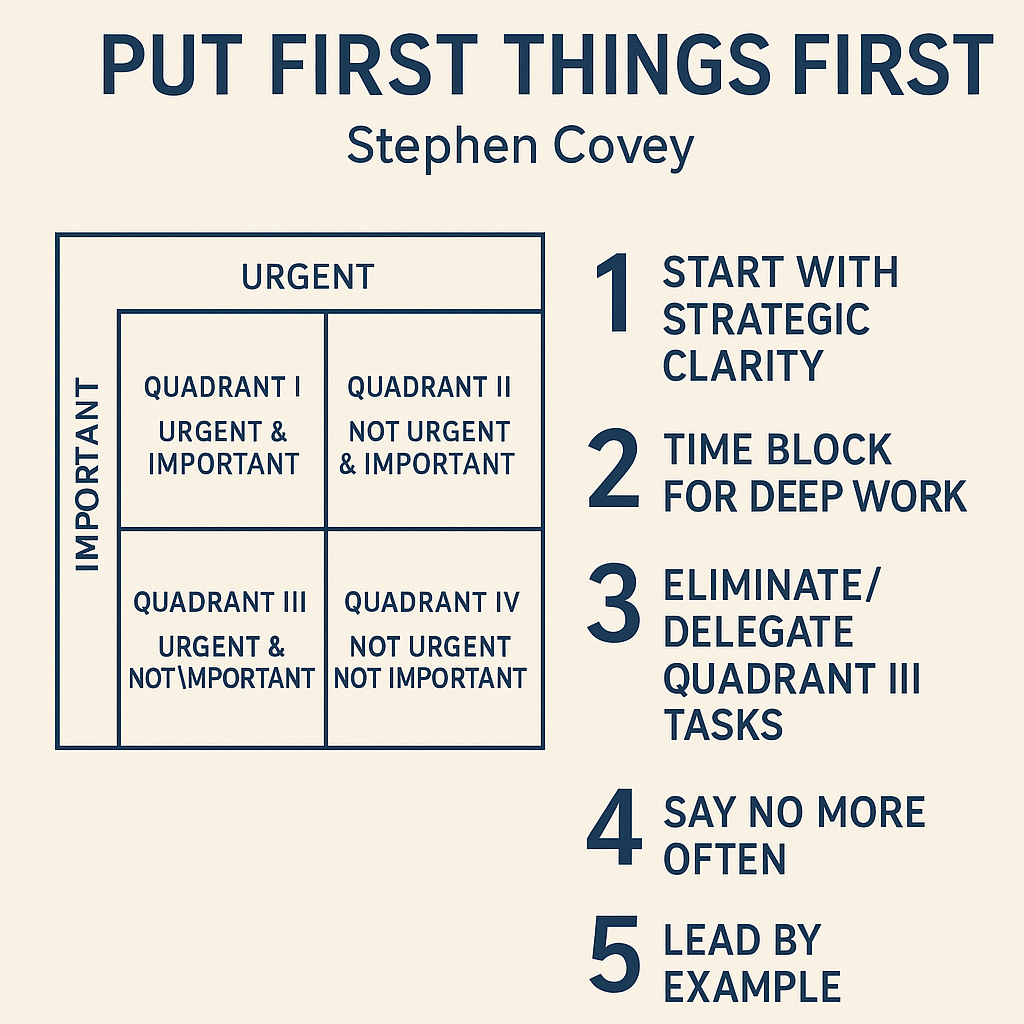Put First Things First – Time Management Strategies for High-Performing Leaders
By John Burt, Executive Leadership Coach
If you’re in a senior leadership role, chances are your days are filled with meetings, decisions, and competing demands. Time is your most limited—and most valuable—resource. But here’s the truth: great leaders don’t manage time; they manage priorities.
That’s why one of the most transformative principles I’ve learned and pass as an executive coach comes from Stephen R. Covey: 👉 Put First Things First.
This concept isn’t just a time management technique—it’s a mindset shift. It challenges us to focus not on what’s urgent, but on what’s important. When you lead with this mindset, you increase your effectiveness, reduce reactivity, and create space for strategic thinking.

Stephen R. Covey’s Time Management Matrix
The Leadership Challenge: Urgency Overload
Most executives live in what Covey called Quadrant I and Quadrant III of his Time Management Matrix:
-
Quadrant I: Urgent and Important (e.g., crises, deadlines)
-
Quadrant III: Urgent but Not Important (e.g., interruptions, busywork)
While Quadrant I is unavoidable at times, many leaders become trapped in Quadrant III—reacting to noise instead of focusing on what truly drives progress.
High-Impact Leadership Lives in Quadrant II
Quadrant II is where the magic happens:
-
Strategic planning
-
Coaching and developing your team
-
Strengthening key relationships
-
Investing in innovation and long-term growth
These activities are important, but rarely urgent. That’s why they get pushed aside. Covey’s brilliance lies in reminding us: If you don’t make time for important things now, they often become urgent—or lost—later.
5 Ways to “Put First Things First” as a Leader
Here’s how I guide executive clients in aligning their time with their impact:
1. Start with Strategic Clarity
Define your top 3–5 priorities for the quarter. Ask:
-
Where can I add the most value?
-
What initiatives align with the organization’s long-term goals?
Your calendar should reflect these answers.
2. Time Block for Deep Work
Schedule protected blocks for focus—no meetings, no emails. Use this time for big-picture thinking, planning, or content creation. These sessions are where breakthroughs happen.
3. Eliminate or Delegate Quadrant III Tasks
Conduct a time audit. What’s filling your schedule that doesn’t align with your core priorities? Delegate what you can. Eliminate what you must.
4. Say “No” More Often
Saying no doesn’t make you less collaborative—it makes you more focused. Try:
“That’s a valuable idea, but it’s not aligned with our current priorities. Let’s revisit it next quarter.”
5. Lead by Example
Your team will take their cues from how you manage your time. If you model intentionality, they’ll follow suit. If you’re constantly reactive, they’ll mirror that too.
Final Thought: Time Management Is Leadership in Action
Putting first things first isn’t about doing more—it’s about doing what matters most. As a leader, your effectiveness isn’t measured by how busy you are—it’s measured by how aligned your time is with your mission, your team, and your strategic goals.
When you manage your time with purpose, you lead with power.
Ready to lead with greater clarity and intention?
As an executive coach, I help leaders move from overwhelm to alignment—transforming how they lead and how they live. Let’s talk about how you can unlock more focus, flow, and impact.
📩 Contact John | 💼 Book a Discovery Session | 🔍 Explore Coaching Programs

